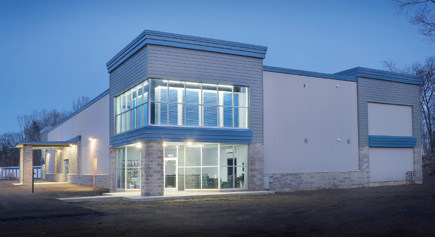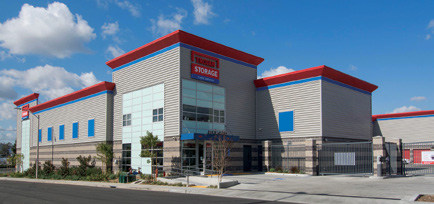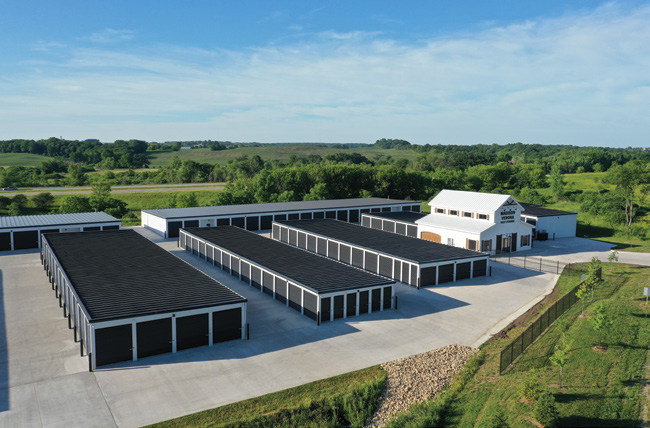Self Storage Industry Trends
by Marcy Marro | 1 September 2022 12:00 am
The self storage industry continues to grow at a remarkable rate, even through the pandemic

Photo courtesy of Tracte Building Systems
Over the last five years, there has been 255.5 million square feet of storage space built, equivalent to 16% of the total inventory. With one in three Americans using self storage units, the self storage industry is quite robust.

Photo courtesy of Metl-Span
Pandemic-Driven Demand
The COVID-19 pandemic effected a lot of businesses and industries in a variety of ways. While many companies struggled to keep their doors open during times of shutdowns, the self storage industry saw demand for extra space surge during the pandemic.
As people started working from home full time and children were doing school at home, many families realized they needed more space for a home office or study space. “We’ve become a society that lives in excess, and the pandemic amplified it, with working from home and being dependent on shipping to home,” says Joseph Calsada, business development manager for Metl-Span[1], Lewisville, Texas. “We need space to put stuff, so the industry is growing for self storage. The industry is making a lot of money from the units and growth of the market.”
Additionally, as people suddenly had extra time on their hands and found new interests, many were related to outdoor activities such as cross-country traveling, boating, sailing and other DIY projects. Some companies, such as Heritage Building Systems[2], North Little Rock, Ark., saw an uptick in requests for RV and boat storage facilities. “During the pandemic many folks saw themselves with discretionary income, which they used to buy campers, ATVs, side-by-sides, jet skis, weight equipment and at-home shops,” notes Fredrick Moore, general manager, Heritage Building Systems. “Many neighborhood associations do not allow these to be stored at home and they did not have space in the garage. The need for mini-storage units skyrocketed. In fact, we have heard from many of our long-term customers that they needed to expand to keep up with the demand.”
Michael Naughton, CSI, CDT, business development manager, Pacific Northwest region, for Metl-Span, notes that rather than growing their home when they added more stuff, many people turned to storage units. “This is another impact from the pandemic and the cost of single-family homes increasing so much they can’t afford larger homes. There is growth in business as well as more companies are manufacturing in the U.S. and are doing more commercial storage, but the largest impacts are in single-family homes.”

Photo courtesy of McElroy Metal
Season of Growth
As shown in the Storage Café trends, the self storage category has seen an impressive amount of growth year over year. “Many customers have seen a consistent pace of new projects as companies have looked to take advantage of a steady and rising demand for self storage units,” says Matt Cox, vice president, component sales, Cary, N.C.-based Cornerstone Building Brands[3].
Earlier this year, Moore notes there was an increase in self storage projects, and that it’s believed the threat of interest rate hikes, steel prices falling and increased interest in land acquisitions have all attributed to more projects being started so rapidly. “Now half-way through the year, this has tapered some,” he says. “But there is typically a slow down during summer months.”
“The market has jumped about 30% over four years, and we continue to see growth,” explains Naughton. “I’ve seen a large increase in development projects, mostly in new construction. These developers need to get facilities up quickly. They have a big rush to get them up fast to get them filled, and they can use IMPs to do that with a complete building envelope component system.”
Low interest rates throughout 2020 and 2021 are another reason the industry has been booming. “When the economy is booming people tend to purchase more items,” says Tracy Kirk, territory manager at McElroy Metal[4], Bossier City, La. “When they purchase more items, they need extra space to store them. Whether it be boat and RV storage for toys, or whether it be single storage units to store household items, the market has not slowed down as of yet. With that being said, I do feel that the bubble will pop eventually. I’m not sure that the market can sustain the rapid growth and saturation at the current pace.”
According to Storage Café, Dallas-Fort Worth-Arlington, Texas, had the largest existing inventory of self storage space, while Heber, Utah, had the most self storage square footage per capita in 2021. In terms of new self storage development activity, Storage Café reports that New York, N.Y.-Newark, N.J.-Jersey City, N.J., had the most self storage construction in 2021 with 2.6 million square feet completed, followed by Dallas-Fort Worth-Arlington, Texas, and Philadelphia-Camden, N.J.-Wilmington, Del.
“Self-storage growth tends to follow population growth,” Steve Hajewski, marketing manager, Trachte Building Systems[5], Sun Prairie, Wis., explains, “therefore much of the activity is in states with net population growth.” Cox agrees, saying Cornerstone is seeing an increase in new self storage projects in states across the Sun Belt, which are outpacing northern markets. “Heritage Building Systems is seeing a steady demand nationwide,” adds Moore. “However, most of these projects are being placed near largely populated areas, recreational areas, and near apartment complexes.”

Photo courtesy of McElroy Metal
Design Trends
Self storage facilities require few employees to operate and can be fully automated. Moore notes Heritage has seen a trend in requirements for storage projects that are unmanned with automated technology.
In terms of design, Moore says there hasn’t been a significant number of changes in recent years, outside of seeing an uptick in more multilevel mini-storage and more high-tech units where customers can self serve. “Regarding the size of units, Heritage Building Systems most often get requests for units that are 10 feet by 10 feet and 10 feet by 15 feet. We’ve seen fewer requests for smaller units. For boat and RV storage, 15 feet by 50 feet deep are most popular. We believe the larger RV units are because the size of the actual vehicles has gotten bigger over time.”
Additionally, Moore notes that project sizes have increased over the years. Five years ago, he says most projects had one to three buildings spec out, while currently, it’s not uncommon to get eight to 15 buildings on a single project. “Either customers are responding to the high demand and building what they have already presold; or the customer profile has shifted from being just mom-and-pop operators to larger companies and investors entering the market,” he adds.
“Much as hotels are available in a variety or price levels, self storage development has evolved to offer a range of quality levels,” explains Hajewski. “Many newer properties have high-end curb appeal and features—this is done to cater to upscale markets, and also to gain zoning approval in premium real estate locations. Automation and online rentals have reduced the need for on-site offices, so we are seeing less emphasis on large offices. On-site manager apartments are a thing of the past.”

Photo courtesy of Tracte Building Systems
According to Cox, Cornerstone has seen an increase in multistory projects and the utilization of more diverse materials for the exterior finish and appearance. “From insulated metal panels, architectural metal panels, and composite materials, self-storage owners are creating more appealing, attractive buildings with the expectations that it can drive incremental rental revenue,” he says.
Calsada shares that a developer he has been meeting with wants to create nice-looking buildings with a storefront and a unique design to draw people in for a slate of 50 projects planned over the next two or three years. “On the back of the house with the actual units doesn’t need to be as aesthetic, but they’re really looking for that front end on the street to pop with color and design. The IMP works great for protection and flair. Self storage owners are smart. They’re all about location with sites right off freeways and have big signs to get attention. These designs catch attention and draw people in.”
Self storage facilities want to be visible and match the area they’re in, says Naughton. “Owners spend a lot of time and money on detail on color and variation, often using two or three panel types. Sometimes the store front will integrate curtainwall and aluminum siding between IMPs, offering a more architecturally pleasing look to stand out.”
While storage units used to be single-story basic builds, Kirk notes that the current trend is to build multistory units and/or renovate older existing buildings to turn them into self storage. “Building a project higher (having multiple floors to the facility) is generally less expensive than if you purchased the additional land and spread a project out over that acreage with single-story units,” he explains. “In addition to that, many high rent areas in certain cities find themselves land locked. Los Angeles and Scottsdale, Ariz., are a good depiction of that. The price of land is much more expensive in these areas, so adding additional floor levels to a project in lieu of purchasing costly land, ensures that the client can maximize their rental potential without having to find additional land options.”
Existing building renovations are becoming more popular as well, Kirk adds. “With this option, a client is purchasing an existing building, gutting the interior and then building the storage units inside of it. It can be costly to rehab an existing structure if you are not familiar with the pitfalls, however the pay off when a project is done correctly, can be huge. This option is good when attempting to open a self storage in an area that has a prime location but may be land locked. As long as the purchase of the building is cost effective and the engineering of the building is good enough to sustain the remodel, a renovation can be a very good choice. It does however take experienced crews to pull this off effectively as you will be fitting a building within another building. I think we will continue to see this form of storage building expand in the years to come. Everyone loves to recycle!”

Photo courtesy of Heritage Building Systems
Looking Ahead
Retrofitting existing buildings into more storage units is a trend that others are seeing as well. Moore notes that Heritage is seeing an uptick in request for hallway systems, which is part of this trend. Noting that retrofits of existing, available commercial and retail space could prove out to be a trend in the coming years, Cox says, “Depending on the economy, interest rates and demand, self storage owners will seek new, cost-effective ways to erect new locations.”
“Rising interest rates will likely slow new development, especially for highly leveraged developers,” adds Hajewski. “The trend toward online move ins with no on-site offices will expand into larger properties. The popularity of larger boat and RV units will continue in areas where high rental rates and low enough land prices exist.”
On the design side, Kirk thinks there will be more changes in regards to exterior finishes and materials being used. “The days of a one color, exposed fastener panel being used for an exterior wall is becoming much rarer to see,” she explains. “Aesthetics of a project have now become as important to the neighborhoods and communities that they are built in as the location is. We are seeing units with multiple colors pallets, different panel types, and more complex building finishes than ever before. Aesthetics will continue to play a major role as self storage continues to evolve.”
- Metl-Span: https://www.metlspan.com/
- Heritage Building Systems: https://www.heritagebuildings.com/
- Cornerstone Building Brands: https://www.cornerstonebuildingbrands.com/
- McElroy Metal: https://www.mcelroymetal.com/
- Trachte Building Systems: https://www.trachte.com/
Source URL: https://www.metalconstructionnews.com/articles/self-storage-industry-trends/